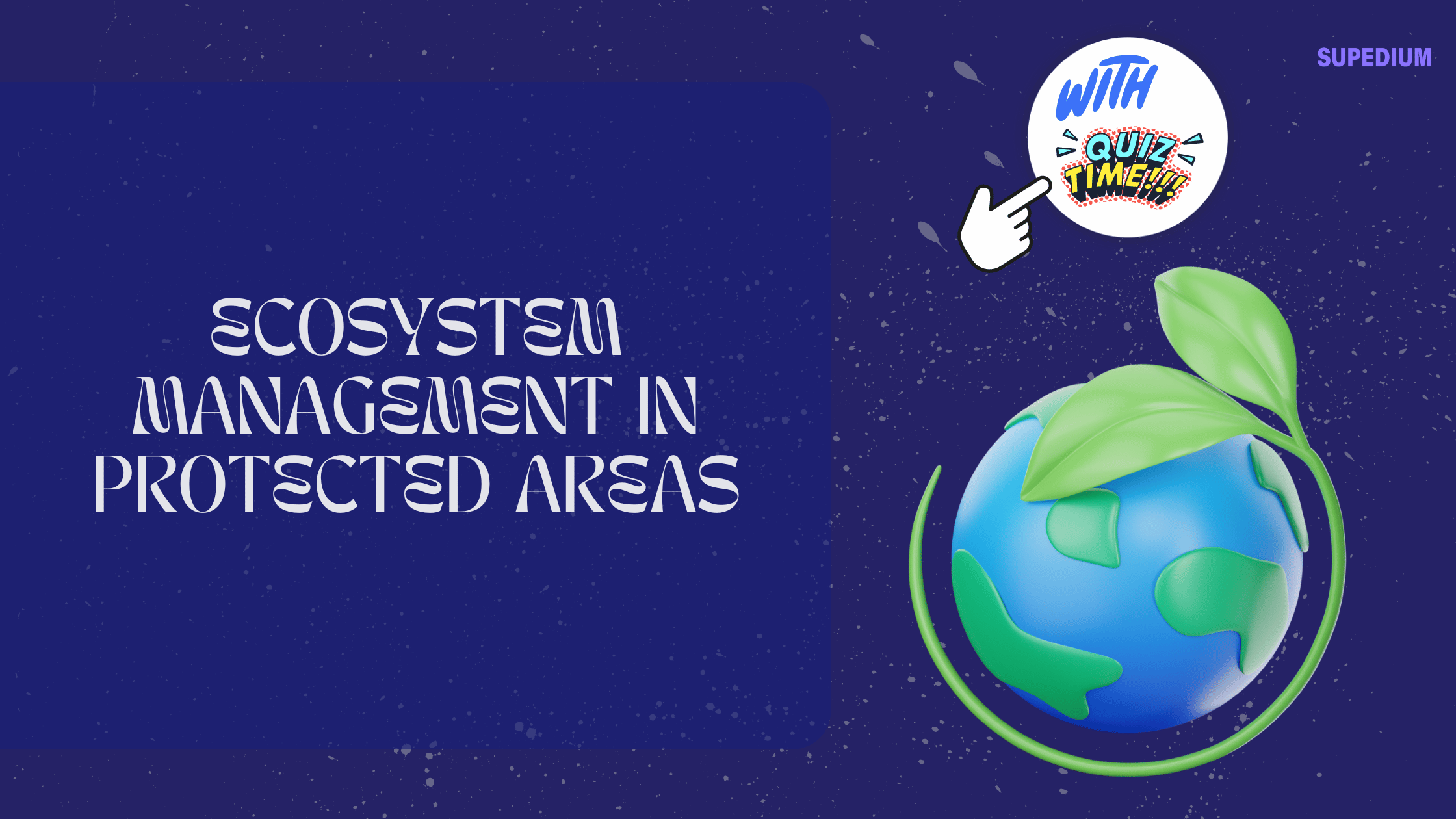Table of Contents
![]()
I. Introduction
Ecosystem management is a holistic approach that aims to maintain and restore the health of ecosystems while balancing human needs and conservation goals. This method is especially crucial in protected areas, where the primary aim is to preserve natural environments and biodiversity. Protected areas, such as national parks, wildlife sanctuaries, and nature reserves, play a pivotal role in conservation by safeguarding habitats, species, and ecological processes. Integrating ecosystem management into these areas helps address the complexities of conserving biodiversity while accommodating human activities and addressing environmental challenges.
II. Principles of Ecosystem Management
A. Ecological Integrity
Maintaining ecological integrity involves preserving the natural processes and functions of an ecosystem. This principle emphasizes the importance of ensuring that ecosystems continue to operate within their natural range of variability. It includes protecting biodiversity, ensuring the survival of species, and sustaining ecological processes such as nutrient cycling and water purification. By focusing on ecological integrity, management strategies can enhance the resilience of ecosystems against disturbances and changes.
B. Adaptive Management
Adaptive management is a dynamic and iterative process that involves continuous monitoring and assessment of ecosystem health. This approach allows managers to adjust strategies based on feedback and new information. By employing adaptive management, protected areas can respond more effectively to unforeseen challenges and changing conditions, ensuring that conservation goals are met despite uncertainties.
C. Ecosystem Services
Ecosystem services are the benefits that humans derive from ecosystems. These services are categorized into four main types:
- Provisioning Services: These include resources such as water, food, and medicinal plants that are directly used by humans.
- Regulating Services: Ecosystems play a critical role in regulating climate, water quality, and disease.
- Cultural Services: These encompass recreational, aesthetic, and spiritual values that contribute to human well-being.
- Supporting Services: Fundamental processes like soil formation, nutrient cycling, and habitat provision fall into this category.
Understanding and valuing these services is crucial for effective ecosystem management, as it helps in making informed decisions that benefit both ecosystems and human communities.
D. Integrated Approach
An integrated approach involves collaboration among various stakeholders, including government agencies, non-governmental organizations (NGOs), local communities, and scientists. This interdisciplinary method ensures that diverse perspectives and expertise are incorporated into management decisions, leading to more effective and sustainable outcomes.
III. Strategies for Ecosystem Management in Protected Areas
A. Conservation Planning
Effective conservation planning begins with setting clear objectives and goals for protected areas. This involves identifying key species, habitats, and ecological processes that need protection. Planning also includes assessing potential threats and developing strategies to address them. Comprehensive conservation plans guide management actions and ensure that conservation targets are met.
B. Habitat Restoration
Habitat restoration aims to return degraded or altered habitats to their natural conditions. Techniques for habitat restoration include reforestation, wetland reconstruction, and invasive species removal. Successful restoration projects, such as the reintroduction of native species or the rehabilitation of degraded lands, demonstrate the potential for restoring ecosystem functions and enhancing biodiversity.
C. Sustainable Use of Resources
Balancing conservation and resource use is a critical aspect of ecosystem management. Managing tourism and recreation involves setting limits on visitor numbers, implementing guidelines to minimize environmental impact, and promoting eco-friendly practices. Additionally, sustainable resource extraction, such as controlled fishing or regulated logging, ensures that natural resources are used responsibly without compromising ecological health.
D. Fire and Pest Management
Fire plays a natural role in many ecosystems, influencing species composition and habitat structure. Management strategies for fire include controlled burns and firebreaks to prevent uncontrolled wildfires. Pest management involves monitoring and controlling invasive species that threaten native biodiversity. Effective pest management strategies may include biological control methods, habitat modification, and public awareness campaigns.
IV. Challenges in Ecosystem Management
A. Climate Change
Climate change poses significant challenges to ecosystem management by altering temperature, precipitation patterns, and sea levels. These changes can disrupt ecosystems, shift species distributions, and affect ecological processes. Adapting to climate change involves developing strategies to enhance ecosystem resilience, such as protecting climate refugia, restoring degraded areas, and mitigating greenhouse gas emissions.
B. Human-Wildlife Conflicts
Human-wildlife conflicts arise when wildlife activities threaten human livelihoods or safety. Examples include crop damage by herbivores or predation on livestock by carnivores. Addressing these conflicts requires implementing solutions such as building protective barriers, using non-lethal deterrents, and involving local communities in conflict resolution efforts.
C. Funding and Resources
Securing adequate funding and resources is a major challenge for managing protected areas. Financial constraints can limit the ability to implement effective management strategies, conduct research, and maintain infrastructure. Strategies to address funding challenges include diversifying funding sources, building partnerships with private sector organizations, and developing innovative funding mechanisms.
D. Legal and Policy Issues
Legal and policy frameworks are essential for the effective management of protected areas. National and international regulations establish guidelines for conservation and resource use. However, policy gaps and inconsistencies can undermine management efforts. Addressing these issues involves advocating for stronger policies, improving enforcement mechanisms, and fostering international cooperation.
V. Case Studies
A. Success Stories
One example of a successful protected area is the Yellowstone National Park in the United States. Yellowstone’s management strategies, including habitat restoration, wildlife monitoring, and visitor education, have contributed to the recovery of key species such as the gray wolf and bison. The park’s success demonstrates the importance of a comprehensive management approach and collaboration among various stakeholders.
B. Challenges and Failures
In contrast, the Galápagos Islands have faced significant challenges due to invasive species and unsustainable tourism practices. Despite conservation efforts, the introduction of non-native species has impacted native flora and fauna. Analyzing these challenges highlights the need for ongoing management adaptations and proactive measures to prevent future problems.
VI. Future Directions
A. Innovations in Ecosystem Management
Technological advancements, such as Geographic Information Systems (GIS) and remote sensing, offer new tools for monitoring and managing ecosystems. These technologies provide detailed data on habitat changes, species distributions, and environmental conditions, enabling more informed decision-making. Emerging management approaches, such as ecosystem-based management and novel conservation strategies, also show promise for enhancing ecosystem health.
B. Enhancing Community Engagement
Involving local and indigenous communities in ecosystem management is crucial for achieving sustainable outcomes. Community engagement ensures that management practices align with local knowledge and values. Strategies for enhancing engagement include incorporating traditional ecological knowledge, promoting participatory decision-making, and supporting community-led conservation initiatives.
C. Global Collaboration
Global collaboration plays a vital role in addressing transboundary environmental issues and sharing best practices. International organizations, such as the International Union for Conservation of Nature (IUCN) and the Convention on Biological Diversity (CBD), facilitate cooperation and provide frameworks for global conservation efforts. Building partnerships and networks across borders can enhance the effectiveness of ecosystem management initiatives.
VII. Conclusion
Ecosystem management in protected areas is a multifaceted approach that requires balancing conservation goals with human needs. By adhering to principles such as ecological integrity, adaptive management, and integrated approaches, managers can address the challenges facing protected areas. Successful case studies and emerging innovations offer valuable insights into effective management practices. Continued research, community engagement, and global collaboration are essential for ensuring the long-term health and sustainability of ecosystems in protected areas.






Be the first to comment